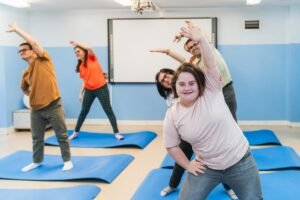Dōsa-hō

Dōsa-hō
What is Dōsa-hō?
Dōsa-hō (meaning “process of self-striving”) is a unique therapeutic modality developed in Japan by Dr. Yasuhito Naruse. This approach focuses on enhancing body awareness, self-control, and the connection between intention and movement. It’s considered a psycho-rehabilitation method primarily used to support individuals with conditions like cerebral palsy, Down syndrome, and other developmental challenges.
How Can Dōsa-hō Help You?
Dōsa-hō offers individuals a way to develop a deeper understanding of their bodies and how their intentions translate into physical actions. This therapy can assist in the following ways:
- Improved motor skills: Dōsa-hō promotes greater control and coordination of movements, enhancing overall motor function.
- Enhanced attention and focus: Dōsa-hō emphasizes mindfulness of the body and its actions, training an individual’s attention and focus.
- Increased self-awareness: Dōsa-hō cultivates a heightened awareness of internal intentions, physical sensations, and the connection between the two.
- Reduced distress: The focus on movement and body awareness in Dōsa-hō can have calming and regulating effects, potentially reducing distress.
- Greater self-efficacy: Dōsa-hō builds confidence in one’s ability to control their own body and movements, fostering a sense of self-efficacy.
What is Dōsa-hō Good For?
Dōsa-hō is primarily used to address challenges experienced by individuals with the following conditions:
- Cerebral palsy: Dōsa-hō can help improve motor control, coordination, and reduce spasticity in individuals with cerebral palsy.
- Down syndrome: Dōsa-hō can support individuals with Down syndrome in developing greater motor control and body awareness.
- Developmental coordination disorder (DCD): Dōsa-hō can help with movement coordination and planning in individuals with DCD.
- Other developmental challenges: Dōsa-hō may be beneficial for individuals with a range of developmental delays or challenges affecting movement.
Benefits of Dōsa-hō
Dōsa-hō offers potential benefits to individuals across the lifespan:
- Improved movement coordination: Dōsa-hō can lead to smoother, more controlled, and efficient movements.
- Enhanced daily life functions: Improved motor skills in Dōsa-hō translate to better performance of everyday tasks and activities.
- Increased self-confidence: Dōsa-hō fosters self-confidence and a sense of agency over one’s body and actions.
- Boosted independence: Improved motor skills and self-efficacy through Dōsa-hō contribute to greater independence in daily life.
- Enhanced quality of life: Dōsa-hō can positively impact various aspects of well-being, leading to an overall improved quality of life.
What to Expect from Dōsa-hō with a Practitioner
A Dōsa-hō session is typically conducted with a trained therapist and follows these general principles:
- Observation: The Dōsa-hō therapist carefully observes the individual’s movements, postures, and patterns.
- Gentle guidance: Using gentle touch and physical manipulation, the therapist guides the individual’s movements.
- Focus on intention: The therapist emphasizes awareness of internal intentions and their connection to physical movements.
- Individualized approach: Dōsa-hō sessions are tailored to the unique needs and abilities of each individual.
Similar Modalities to Dōsa-hō
Other therapeutic modalities share similarities with Dōsa-hō:
- Feldenkrais Method: The Feldenkrais Method uses gentle movements and guided exploration to enhance body awareness and movement efficiency.
- Conductive education: Conductive education is a holistic approach for individuals with motor disorders, focusing on developing motor skills and cognitive abilities.
- Occupational and physical therapy: These therapies often incorporate body awareness, movement coordination, and strategies to improve daily function.
Final Thoughts
Dōsa-hō provides a unique framework for individuals seeking to improve their motor control, body awareness, and overall well-being. Its emphasis on the connection between intention and movement makes Dōsa-hō a valuable tool, particularly for those with developmental challenges. If you or a loved one are seeking support with motor function and coordination, exploring Dōsa-hō might be a transformative step in your journey.
Scientific References
While peer-reviewed scientific research on Dōsa-hō specifically is limited, here are references exploring related concepts and therapies with overlapping principles:
- Knox, S. H., & Beamer, S. B. (1996). Evaluation of behavioral treatment of sensory integration problems in children with autism. Occupational Therapy Journal of Research, 16(2), 73-92. doi:10.1177/153944929601600201
- Rinehart, N. J., Bell, E. C., & Greenfield, D. B. (2017). Perspective of caregivers of children with autism spectrum disorder on sensory-based intervention: A qualitative study. The American Journal of Occupational Therapy, 71(5), 7105190020p1–7105190020p8. doi:10.5014/ajot.2017.024835
- Feldenkrais, M. (1972). Awareness through movement: Health exercises for personal growth. Harper & Row.
Recommended Reading
Since much of the foundational literature on Dōsa-hō is in Japanese, here are some resources on related therapies to deepen your understanding:
- The Brain That Changes Itself: Stories of Personal Triumph from the Frontiers of Brain Science by Norman Doidge (2007). Doidge, N. (2007). The brain that changes itself: Stories of personal triumph from the frontiers of brain science. Viking.
- Move into Life: The Nine Essentials for Lifelong Vitality by Anat Baniel (2009). Baniel, A. (2009). Move into life: the nine essentials for lifelong vitality. Harmony Books.
- Spark: The Revolutionary New Science of Exercise and the Brain by John Ratey (2008). Ratey, J. (2008). Spark: The revolutionary new science of exercise and the brain. Little, Brown and Company.
FAQ: Dōsa-hō
Is Dōsa-hō only for children?
While Dōsa-hō is widely used with children, it can benefit individuals across different ages who experience challenges with motor control and body awareness.
How is Dōsa-hō different from traditional physical or occupational therapy?
Dōsa-hō places a unique emphasis on the mental aspect of movement and the connection between intention and action, offering a complementary approach.
Where can I find a Dōsa-hō practitioner?
Due to its specialized nature, finding Dōsa-hō practitioners might require some research. Start by contacting developmental therapy centers, organizations specializing in cerebral palsy or Down syndrome, or inquiring within holistic healthcare networks.
How long does it take to see results with Dōsa-hō?
Like any therapy, progress with Dōsa-hō is individually variable. Consistency and ongoing practice are key for seeing significant benefits.
Can Dōsa-hō be done at home?
While working with a trained Dōsa-hō therapist is essential, some elements of practice might be adapted for integration into daily life with their guidance.











